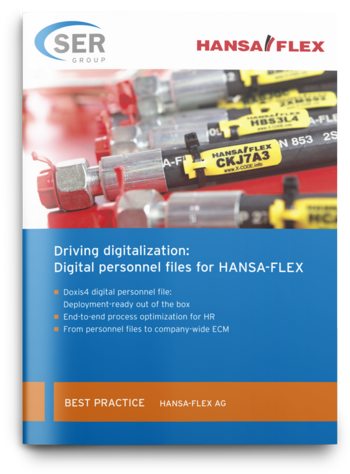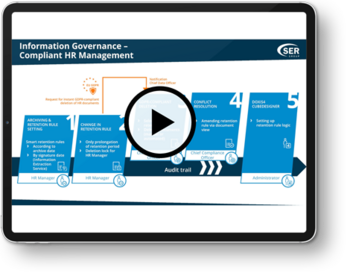SER Blog Customer Stories & Use Cases
A digital awakening in Human Resources
Hybrid work schedules, shortages of qualified professionals, burgeoning administrative tasks: HR departments are playing catch-up with digital transformation. So how can they overcome these challenges and build modern work environments? With intelligent digital solutions.

Digital transformation in HR
It’s no coincidence that the successful businesses that stand out in today’s marketplace have turned digitalization to their advantage. Their all-encompassing digital transformation strategies extend beyond the business model and digital customer services to also reach internal administrative processes. And HR is no exception. Digitalization in Human Resources includes:
- recruitment,
- onboarding and offboarding,
- employee development,
- contract management & negotiations, and
- managing access to personnel files
Challenges growing in HR departments
Digital support cuts down on time-consuming manual searches for documents and information, freeing up users to focus on core tasks instead. Not only that, but it can also be a great asset as we move into a new era of hybrid work schedules that bring added complexity for HR departments. They are under pressure to find qualified professionals, help employees develop their digital literacy skills and be on hand to assist with inquiries — all while dealing with a burgeoning number of administrative tasks.
Despite this, around 68% of HR experts surveyed in the SER Group’s ECM Insights study* from 2020 do not have a digital HR management solution in place. When asked which tools the responding companies use in HR, the majority (56%) still relies on paper. This was followed closely by file systems, Excel and emails (multiple answers possible). . Of those who do rely on digital solutions, 44% report using SAP SuccessFactors, while electronic HR files are only used by 32%.
The importance of digitalization is growing
Findings from other studies, such as the 2020 HR study conducted by Martin Luther University Halle-Wittenberg, paint a similar picture. But while it’s clear that HR managers are champing at the bit to get the digital transformation under way in their departments, they hitherto appear to have been afforded little consideration in the context of company-wide digitalization. The initial focus for businesses has been on areas with external visibility — areas like customer service, for example. Yet HR, as the department that looks after the people behind every (digitalized) business process, is just as in need of support with realizing its digitalization plans. So, what can HR departments do to work more efficiently and speed up their internal processes?

Speed up & streamline HR processes
This is how Doxis Human Resources helps you digitally manage all HR documents and personnel processes quickly, clearly and securely.
Read nowDigitalization: More than just HR data
Dedicated HR or payroll systems, like SAP SuccessFactors, are often the most obvious choice for HR departments. They’re also great for managing employee data. On the other hand, they neglect to account for the myriad documents that HR teams work with daily. And, as anyone who has ever had to wade for information through mounds of application documents, insurance policies, contracts, wage slips, travel expense claims and vacation requests will attest: paperwork can pile up quickly. So, you just scan everything and work with it on screen? Yes, but there’s also much more to it than that.
Process optimization with ECM
Far more crucially, it’s about how HR documents and data can be made available, retrieved and managed in the right context and process — regardless of the end device or system. This is exactly what an intelligent process and information management solution offers: enterprise content management (ECM) from SER is one such platform already used by many companies.
A 360° view of employees
The first step on the journey to digital HR work is to digitize information so it can be accessed electronically. An ECM system lays this foundation by combining all documents on employees with their personnel master data, emails and more in digital personnel files. While you can do this with conventional electronic personnel files, what lets the latter down is their inability to provide a comprehensive view of associated tasks and processes. With a state-of-the-art solution, tasks and processes are digitally mapped and made available in the right context. By deploying a modern ECM system, businesses introduce all-round visibility that extends far beyond the eFile and its contents: information and processes can be found, worked on and managed via a single unified solution.
End-to-end HR workflows with ECM
Many companies are put off by the belief that digital HR solutions are complex to implement. But rollout can be easy and fast with an ECM system that offers personnel eFiles with a uniform folder structure, along with functions for filing, searching, versioning and managing documents. And digitalization now opens up so many more opportunities than solely document and workflow management. Artificial intelligence (AI) can be used in combination with automated processes not only to relieve employees of routine tasks, but also to help them locate the information they need, easily comply with regulatory requirements, and much more besides. Doxis offers just that: so businesses benefit from digital personnel files, as well as HR process digitalization and intelligent automation.

HANSA-FLEX: From HR files to company-wide ECM
Learn how HANSA-FLEX took the first step on its digitalization agenda with digital HR files.
Read nowDigitalization in the HR department
Using artificial intelligence and automation lays the foundation for mapping and managing numerous administrative and organizational workflows in HR — much faster than before, for less effort and with end-to-end transparency. Here are some use cases in HR:
Automatically generate new personnel files — No more manual creation of HR files: the system does it automatically whenever a new employee is added in the ERP system such as SAP. Any changes to employee master data, such as their name or address, are automatically updated in the personnel file. It eliminates the need to manually cross-check changes and helps prevent any inadvertent mistakes.
Cross-area onboarding and offboarding — Once the system is automatically creating new personnel files, it can easily be set up to automatically launch the onboarding process, too. The system directly informs everyone involved about the next steps and deadlines, e.g. setting up the new employee’s keycard, laptop and system accesses, ordering a new cell phone, organizing internal training measures and so on. Employee offboarding essentially follows the same procedure in reverse.
Intelligent document filing and routing — An ECM platform is capable of far more than just individual solutions for personnel eFiles in HR. For instance, it can also automate all inbound mail and file inbound documents in the correct personnel file. An AI-based ECM solution recognizes the relevant information without the need for user input and assigns it to the correct place.
Transparent applicant management — Making it easy for HR to view new inbound documents and liaise with the correct department: a workflow forwards the documents for review and the system sends automatic deadline reminders. Following a successful hiring process, the application documents are automatically transferred to the newly created personnel eFile. The documents of unsuccessful applicants are automatically deleted at the end of the application process in accordance with the EU GDPR. This is particularly useful given the stringent guidelines on personal data with prescribed retention periods and deletion deadlines.
Documented compliance — Manually looking after the data of thousands of employees requires a great deal of effort to keep it protected and stored in an audit-compliant way. It’s easy to overlook something. An intelligent ECM platform assists HR by automatically assigning appropriate access restrictions to employee information, complying with statutory retention periods and deletion deadlines, and documenting every step of the way. The end result: complete protection for sensitive information and mitigation of compliance risks for the company.
Access files from anywhere — With paper files, granting access to managers or employees who want to view an HR file is inconvenient and time-consuming. But even digital solutions are no guarantee of improvement: employees are still required to visit HR in person to view the file on screen. With an ECM platform that can give users access to eFiles from anywhere, HR is automatically informed upon submission of a request to view a personnel file — all HR has to do is approve access for a defined window of time. The employee can see the file quickly and easily on any screen. Not only does it simplify the process for all sides, but the eFile also remains available to HR throughout.
Intelligent information management with SAP SuccessFactors integration
SAP SuccessFactors is already deployed in many HR processes. What’s often missing, however, are centralized document management, end-to-end workflows and automated task management. and automated work steps. Doxis builds a “content bridge” to SAP SuccessFactors and thus provides intelligent information management and a seamless user experience. As a central DMS, it automatically creates digital applicant and personnel files and correctly stores master data and documents. All information is available throughout the entire HR lifecycle - in the right place, at the right time, and in the right context. Doxis also ensures compliance by enabling role-based access rights and notifying users via SAP SuccessFactors of expiring contracts and deadlines.

Compliant HR management
Ensure EU GDPR-compliant HR processes with automatic retention rule management and more!
Watch nowA comprehensive approach to digitalization in HR departments
As these examples clearly show, HR departments engage in extensive dialog with employees and departments across the entire company. For this reason, it is essential that they are given a solution which not only improves the way information and processes are managed within HR, but which can also map HR processes from end to end across all areas.
*ECM Insights 2020, study conducted between January and December 2020 by the SER Group among 1,689 CIOs, process and IT managers from companies with over 100 million euros annual revenue.
SAP SuccessFactors meets Doxis
The latest digitization trends, laws and guidelines, and helpful tips straight to your inbox: Subscribe to our newsletter.
How can we help you?
+49 (0) 30 498582-0Your message has reached us!
We appreciate your interest and will get back to you shortly.




